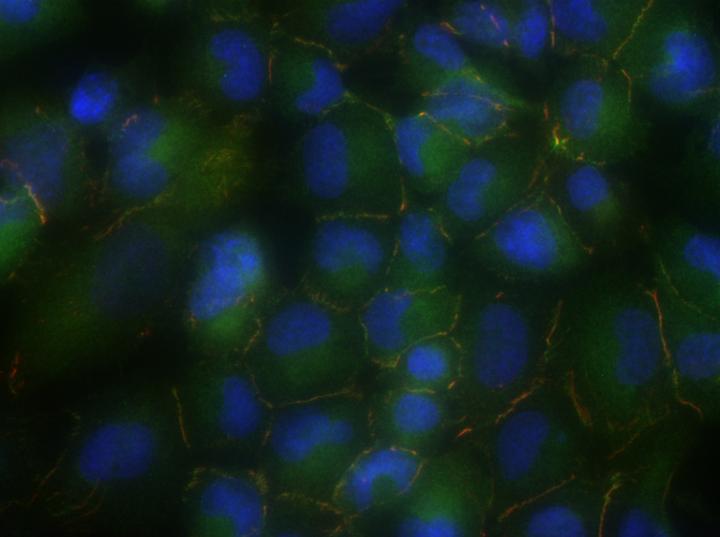Researchers discover an inactive tumor suppressor gene in lung cancer

Correct tight junctions between cells labeled in yellow due to the presence of the protein PARD3. Credit: IDIBELL
Researchers at Genes and Cancer group at Bellvitge Biomedical Research Institute (IDIBELL), led by Montse Sanchez-Cespedes, have identified the PARD3 gene as a tumor suppressor that is inactivated in lung cancer squamous type. The results of the study have been published in Cancer Research.
Correct polarization (orientation in space) of bronchial epithelial cells is essential for the maintenance and proper development of this tissue under normal conditions.
PARD3 gene encodes a protein that regulates cell polarization and cell junctions. When the gene is inactivated, errors occur in this cell orientation and in contact with neighboring cells. “Any change affecting this structure promotes tumor development,” said the researcher Montse Sanchez-Cespedes.
Tumor invasion and metastasis
By restoring protein encoded by PARD3 levels, both, cell lines and animal models of mice, we observed that regulating de novo polarization of cells, significantly reduced the risk of metastasis.
Lung cancer
Lung cancer is one of the tumors having higher mortality rates worldwide. Only in Spain each year about 20,000 people die from this cause. The high mortality rate is mainly due to late diagnosis of the disease, when it is already in an advanced stage.
Late detection and lack of effective therapies make the probability of survival of patients with lung cancer is very low. Overall, only 10% and 15% of patients survive more than five years after detection. The origin of more than 80% of cases is the consumption of snuff. The squamous lung cancer and lung adenocarcinoma type are the two most common types of lung tumor.
###
Article reference
Bonastre E, Verdura S, Zondervan I, Facchinetti F, Lantuejoul S, Chiara MD, Rodrigo JP, Carretero J, Condom E, Vidal A, Sidransky D8, Villanueva A, Roz L, Brambilla E, Savola S, Sanchez-Cespedes M. PARD3 Inactivation in Lung Squamous Cell Carcinomas Impairs STAT3 and Promotes Malignant Invasion. Cancer Res. 2015 Apr 1;75(7):1287-97. doi: 10.1158/0008-5472.CAN-14-2444.
Media Contact
All latest news from the category: Life Sciences and Chemistry
Articles and reports from the Life Sciences and chemistry area deal with applied and basic research into modern biology, chemistry and human medicine.
Valuable information can be found on a range of life sciences fields including bacteriology, biochemistry, bionics, bioinformatics, biophysics, biotechnology, genetics, geobotany, human biology, marine biology, microbiology, molecular biology, cellular biology, zoology, bioinorganic chemistry, microchemistry and environmental chemistry.
Newest articles

Sea slugs inspire highly stretchable biomedical sensor
USC Viterbi School of Engineering researcher Hangbo Zhao presents findings on highly stretchable and customizable microneedles for application in fields including neuroscience, tissue engineering, and wearable bioelectronics. The revolution in…

Twisting and binding matter waves with photons in a cavity
Precisely measuring the energy states of individual atoms has been a historical challenge for physicists due to atomic recoil. When an atom interacts with a photon, the atom “recoils” in…

Nanotubes, nanoparticles, and antibodies detect tiny amounts of fentanyl
New sensor is six orders of magnitude more sensitive than the next best thing. A research team at Pitt led by Alexander Star, a chemistry professor in the Kenneth P. Dietrich…





















